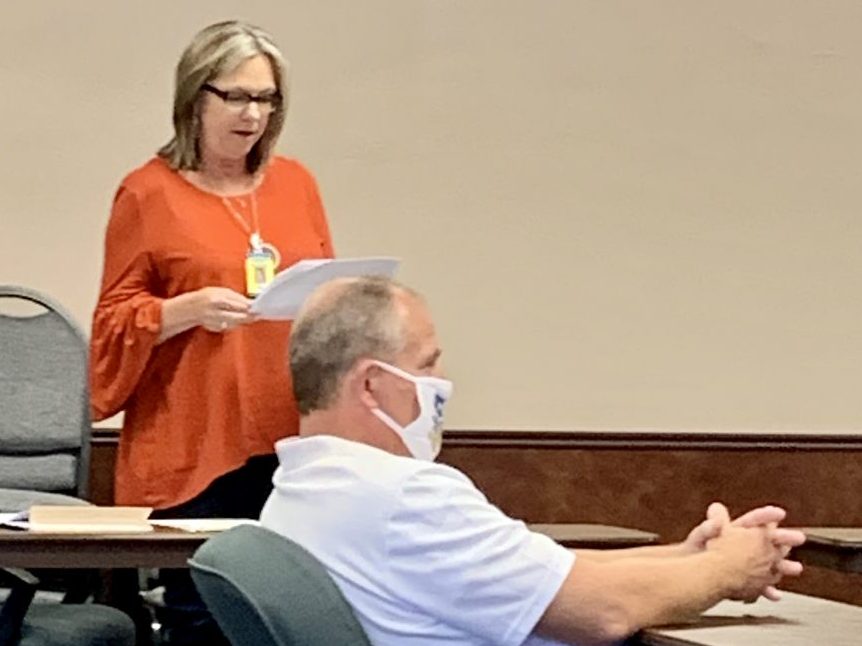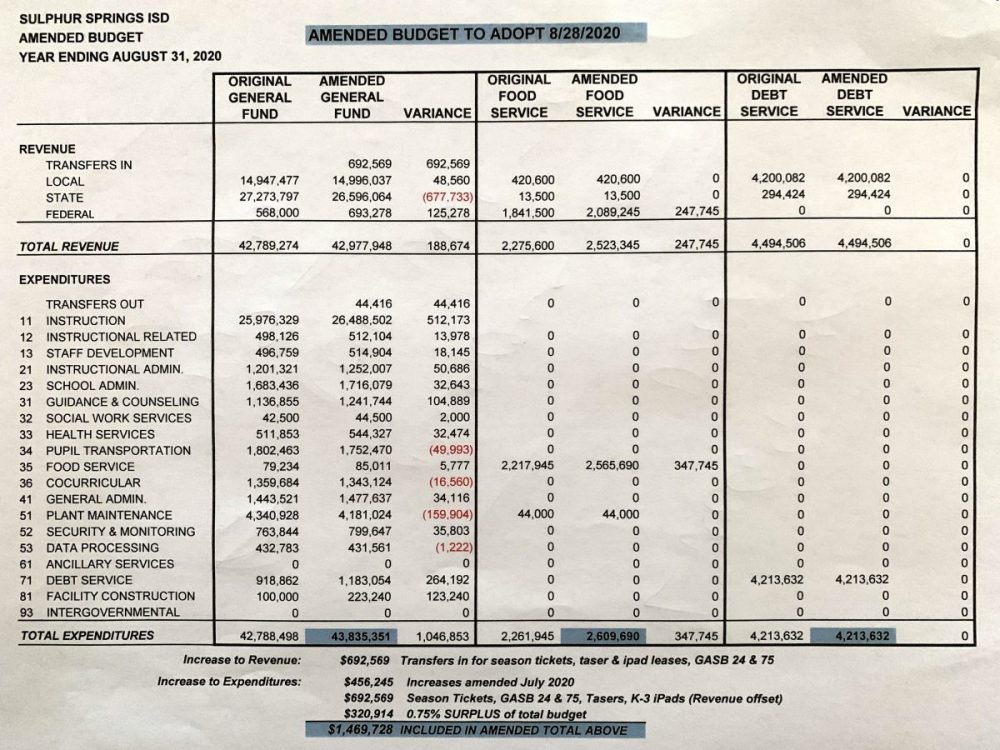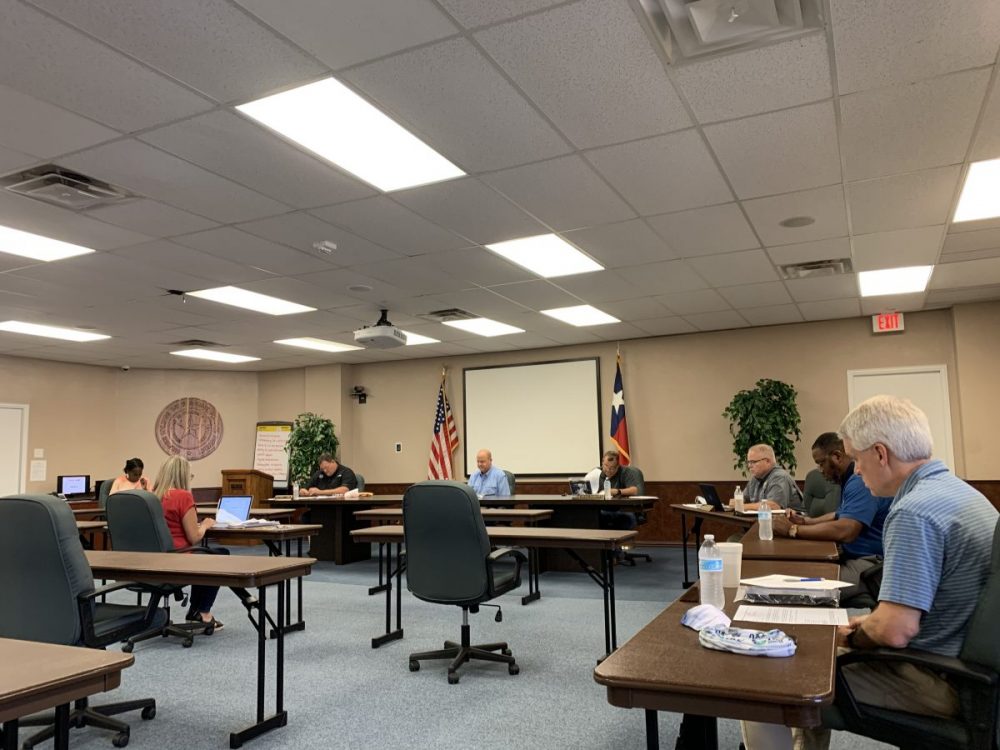Sulphur Springs ISD Board of Trustees during a special called noon meeting Friday, Aug. 28, approved budget amendments, 9 personnel changes, the SSISD 2020 tax rate and the Virtual Academy plan.
SSISD 2020 Tax Rate
SSISD Tax Assessor Collector Sandra Gibby recommended a SSISD 2020 tax rate of $1.251380 per $100 cash valuation of property within SSISD, with $0.9409 of that rate going toward the local maintenance fund for daily operations and the other $0.31048 going toward the debt service, bonded indebtedness, interest and sinking fund.
That’s nearly 3 cents lower than the 2019 tax rate. In fact, over the last 7 years, the tax rate has declined more than 10 cents, dropping from $1.3604 in 2013 to $1.35048 from 2014-2018, then to $1.28048 last year and $1.251380 this year.

While the SSISD 2020 tax rate is lower than the 2019 tax rate, that doesn’t necessarily mean tax bills will be lower, as taxes are based on appraisal values, which are reported to be up. The tax rate was reduced using a formula set by the state, which factors in a 7 percent growth in the overall tax roll from last year.
The school board approved the Ordinance 2-20 levying the SSISD 2020 tax rate as proposed.
Personnel Changes
Eight personnel changes, three resignations and five new hires were also approved by the school board following an executive session.
Stephanie Ricks resigned as a special education aide and Jennifer Virgel as a special education teacher at Sulphur Springs High School. Kristin McKinney was approved to teach special education at SSHS.
Hired as special education aides at Barbara Bush Primary were Leticia Burnside and Erika Flowers. Kylie Wyly will join them at Bush Primary as the campus secretary.
Haylee Head was hired as a Title III aide at Travis Primary.
Amanda Ferrell resigned as an instructional aide at Austin Academic Center.
Budget Amendments
SSISD knew entering the 2019-2020 fiscal year which ends Aug. 31, that the budget would be tight with only $776 expected to be left in the general fund budget at the end of the year.

Business Manager Sherry McGraw presented for trustees approval an amended 2019-2020 budget to reflect expenses and revenues that were not in the original budget approved in August of 2019.
These include a number of items that changed due the end of classroom instruction and in-person activities after spring break due to COVID-19 and the precautions required this summer and in readiness for the 2020-21 school year, which begins on Tuesday, Sept. 1. The overall budget is comprised of three different funds: debt service fund, food service and general fund.
Debt Service
No changes were recommended for the $4,213,632 debt service fund, but the food service and the general fund required amendment.
Food Service
Although school was out, the district still provided meals for student not only through the end of the school year, but all summer as well. The district typically only offers meals through early July. This summer the district offered grab and go meals for any youth age 1-18 from the time school was out through Aug. 28.
The food service expenses increased by $193,449 due to commodities and $54,296 due to the summer food service, but revenue for the same amount offset the increases.
McGraw asked the trustees to approve putting an additional $100,000 in for any unforeseen expenditures, including bills that haven’t yet come, to make sure the fund has a health balance at the end of the year.
That would increase the food service revenues from $2.275 to $2.523 million. Expenditures are anticipated to change from $2.26 million to $2.6 million, a difference of $347,745. The budget must be amended to reflect the changes.
General Fund
This budget includes 19 functionsThe budget adopted for September 2019 was $42,788,498. In July, trustees agreed to amend the budget by $555,171, which adjusted the budget to $43,244.743. This revision included:
- $137,460 COVID-19 with 75 percent reimbursed by the state.
- $31,360 in restructuring costs, including $8,120 for the intercom and sound system at Barbara Bush Primary and $23,240 for restroom reconfigurement at Douglass ECLC).
- $24825 for digital radios, with 75 percent of the cost paid with a grant.
- $139,640 iPads for kindergarten through third grade to equip students with the technology needed to switch to online learning should the school have to close for any length of time due to COVID-19, other illness, weather or other unforseen issues.; the district has requested reimbursement from the state for these.
- $221,886 because IDEA B funds were less than expected.
A few of the functions came in under budget, including $274,330 in pupil transportation budget and $72,546 in co-curricular fund, both because COVID-19 canceled travel to activities and school in the spring. The general administrative fund and plant maintenance funds also finished ahead, with $$43,475 and $492,564 respectively remaining in those funds. Data processing also came in $5,540 ahead. The district also received $677,733 less in state revenue. These changes were approved in July when the budget was amended.

Since July, the district added $692,569 to both expenditures and revenues. Those increases included:
- $44,416 for season tickets
- $22,450 Taser lease balance,
- $411,600 K-3 iPad lease balance
- $85,109 TEA Health Insurance Contribution GASB24
- $129.994 TRS
McGraw recommended adding a certain percentage in surplus to each fund, for a total of $320,914 in surplus to ensure all funds stay within budget, with none exceeding expenditures approved by the board on Aug. 28. That’d be a total of $1,046,853, which would be partially offset by the $692,569 in revenue, reducing the actual increase to $354,284.
“Your approval does not mean we will go out and spend the surplus funds. It just means if any expenditures come in that we were not expecting or if auditors’ adjustments increase or change an expenditure in a function, we have allocated to each function surplus funds in an effort to avoid any findings in our annual financial report,” McGraw explained.
Thus, the board was asked to amend the general fund budget from the $42,788,498 originally projected and from the July 31 amended general fund budget of $42,780,170 to a final general fund budget of $43,835,351.
The board approved the amendment of the food and general fund as recommended by McGraw.
Virtual Academy
The trustees also were asked to approve a Virtual Academy asynchronous plan, required to submit to TEA for approval so the district can receive funding for alternative education plan. The plan has to be turned in by the end of the end of the semester, and approved, in order to continue the program through the spring semester.
Assistant Superintendent of Curriculum and Professional Learning Lisa Robinson said she has been told it’s better to get the plan in by Oct. 1, as there’s a good chance TEA will send the plan back for revision. Robinson said she submitted a letter of intent to have the plan in by Sept. 1. She plans to submit the plan by Tuesday for state feedback.
Superintendent Mike Lamb said the plan is the same plan that was presented previously, but on some levels more indepth but mostly in the terms and language required for TEA. He said he does not think TEA will kick it back for improvements because of the care and thoroughness that went into drafting it, but said the board would be notified if it is.
School administrators and staff have been working hard all summer on the Virtual plan for all grade levels, and more recently working on minutes guidelines with teachers, making sure they budget and spend the required contact time in contact with students, and methods to be used for attendance counts. The plan can be adjusted during the first few weeks of school as needed as teachers, staff and families learn what does an doesn’t work best.
While VA students will be working at their own pace instead of streaming in for a class, there will be a synchronous component with live interaction with staff, but not more than 90 minutes a day.
Virtual students will take the same common assessments that students attending classes on campus are taking. Key assessments are aligned with the same curriculum. Any additional tests would e at the discretion of the teachers.
On-campus staff are also training to use the same kind of online platforms for work in class, that way, if school has to be closed for a short or extended period of time, the transition will be easier. Also, if an oncampus student has to go into quarantine, tests positive or is sick for several days, the student can use the school device to keep up with school work, provided they are well enough to do so, and not fall behind. On-campus teachers would communicate with those students through the online platform. Students would not be in a Virutal Academy, however, as that structure is different.
A few VA teachers will also be doing some on-campus teaching, but not all. All on-campus teachers being trained so that if they have to enter quarantine and feel well enough, they can teach their class from home video the online platform, with someone in the class to monitor students. Lesson plans are built in a way that all pieces are together to the point that a substitute teachers could log in and guide the class
High School students were made aware what classes were available through Virtual Academy and their scheduled adjusted accordingly. Some may have to report to the school at designated time for certain elective course, however, due to the hand-on nature of the course. Teachers had to work on scheduling blocks to incorporate time for those students.
While roughly 18 percentage of all enrolled SSISD students have elected to participate in VA, the percentages vary by school.
Pre-kindergarten is a little higher than 18 percent, 23 percent of Travis Primary students have registered for VA, and 240 high school student had signed up for VA at the high school as of Friday, according to Superintendent Michael Lamb.
A class size waiver request could potentially be request for some Virtual classes.








